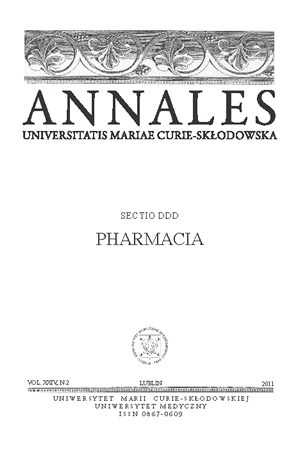Badania konformacji, wewnątrzcząsteczkowego wiązania wodorowego, kwasowości w fazie gazowej oraz termodynamiki hydrolizy leków z grupy fibratów
Słowa kluczowe:
fibraty, analiza konformacyjna, wiązanie wodoroweAbstrakt
W pracy przedstawiono badania obliczeniowe w fazie gazowej leków z grupy fibratów. Wszystkie stabilne konformacje kwasu fibrowego (jako aktywnej struktury wszystkich leków z tej grupy) zostały zoptymalizowane na poziomie B3LYP/6-31+g(d). Najniższą energię zaobserwowano w przypadku konformacji symetrycznej z wiązaniem wodorowym pomiędzy tlenem grupy fenoksylowej a wodorem grupy karboksylowej. Zbliżoną energię otrzymano dla asymetrycznego konformeru bez wiązania wodorowego, istniejącego w dwóch lustrzanych odbiciach. Anion kwasu fibrowego istnieje tylko w dwóch konformacjach – jednej symetrycznej i jednej asymetrycznej. Podstawniki w pozycji para- w kwasie klofibrowym, fenofibrowym i ciprofibracie nie mają wpływu na zachowanie konformacyjne aktywnego fragmentu. Podstawniki te mają dwa minima rotacji wokół wiązania z pierścieniem benzenowym, jedno o wyraźnie niższej energii. Natomiast w przypadku bezafibratu podstawnik ma istotny wpływ na konformacje, tworząc wiązania wodorowe między wodorem grupy amindowej lub wodorami drugiego pierścienia, a tlenem C=O grupy karboksylowej. Chociaż istnieją geometrie bezafibratu bez wiązań wodorowych, mają wyraźnie wyższą energię i ciężko się ich spodziewać doświadczalnie. Dodatkowo obliczono kwasowości w fazie gazowej i entalpie hydrolizy klofibratu i fenofibratu do odpowiednich kwasów.
Bibliografia
1. Ablise M. et al. Molecular pharmacophore determination of lipid lowering drugs with the receptor mapping method. Mini Rev. Med. Chem., 2, 97, 2002.
2. Chapman M.J., Fibrates: therapeutic review. Br. J. Diabetes Vasc. Dis. 6, 11, 2006.
3. Fazio S. et al. The role of fibrates in managing hyperlipidemia: mechanisms of action and clinical efficacy. Curr Atheroscler Rep, 6, 148, 2004.
4. Frisch et al. Gaussian 09, Gaussian, Inc., Wallingford CT, 2009.
5. Henry R.F. et al. Fenofibrate. Acta Cryst. E 59, 699, 2003.
6. Le Y. et al. Electronic structure and UV spectrum of fenofibrate in solutions. Int. J. Pharm. 358, 214, 2008.
7. Matin A. et al. 7-Hydroxy-benzopyran-4-one derivatives: a novel pharmacophore of peroxisome proliferator-activated receptor alpha and -gamma (PPARalpha and gamma) dual agonists. J. Med. Chem., 52, 6835, 2009.
8. Roy A.K. et al. Structures of the formic acid trimer. Chem. Phys. Lett. 386, 162, 2004.
9. Sashidhara K.V. et al. Synthesis and antihyperlipidemic activity of novel coumarin bisindole derivatives. Bioorg. Med. Chem. Lett. 20, 3065, 2010.
Pobrania
Opublikowane
Numer
Dział
Licencja
Prawa autorskie (c) 2011 Autorzy

Praca jest udostępniana na licencji Creative Commons Attribution-NonCommercial-NoDerivatives 3.0 Unported License.


